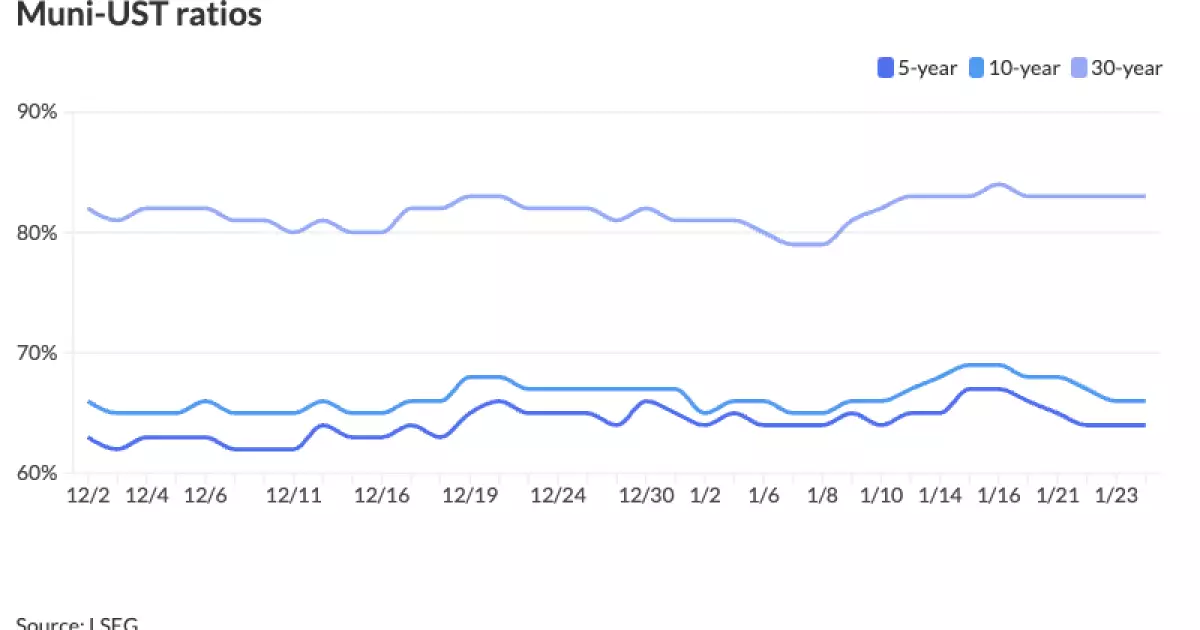Investors in the municipal bond market have faced significant fluctuations recently, influenced by the interplay of U.S. Treasury yields and broader market dynamics. The latest data presents an intriguing picture: as Treasury yields edged downwards, municipal bonds momentarily exhibited steadiness, but the overall sentiment remains complex, with multiple factors at play.
Last week’s market behavior reveals that municipal bonds (munis) initially lagged behind U.S. Treasuries (UST), following a notable rally in Treasury yields. Barclays strategist Mikhail Foux indicated that this was largely due to an aggressive uptick in UST yields of over ten basis points. However, by the week leading up to January 21, municipal bonds had a chance to outshine their Treasury counterparts, despite a flood of new issuances, which typically exerts a downward pressure on pricing. Overall, the market now finds itself at a precarious juncture, characterized by perceived stability but underlying concern.
Foux’s insights suggest that supply dynamics will likely keep issuers active through the early part of 2025 amid ongoing speculation surrounding potential policy changes like the capping or cancellation of tax-exempted bonds. With a 30-day visible supply of $9.631 billion, market observers are acutely aware of these pressures, reflecting both opportunity and risk.
Market Ratios and Investment Viability
The recent ratios of municipal bonds relative to USTs illustrate a tight trading range. The current two-year munis yield approximately 64% of their Treasury counterparts, with slight variances in five- and ten-year bonds. This convergence towards Treasury rates may give rise to concerns about the attractiveness of investing in municipals. Foux has cautioned that this situation creates an “unappetizing” market for municipal investments, where few high-value opportunities exist.
Nevertheless, he highlights California credits as a potential area for astute investors. Despite being perceived as riskier following the devastating wildfires in the region, these credits may offer a rare chance to capitalize on valuations that are currently low. The California index’s underperformance – lagging the investment-grade index by about seven basis points since the onset of the wildfires – may call for a nuanced investment strategy. Investing in these underpriced credits could yield beneficial returns if the market corrects itself as conditions improve.
Looking ahead, the outlook for new bond issuances remains significant. With an estimated $5.151 billion slated for the upcoming week, the market anticipates a variety of high-profile issuances. Leading the pack is the Oklahoma Turnpike Authority, with a robust offering of $1.311 billion in second senior revenue bonds. This supply trend indicates active market engagement, even as current yields present challenges.
As Foux succinctly articulates, although there was a momentary bullish sentiment in the prior week, the optimism was short-lived, returning to a more cautious and neutral stance as market conditions recalibrate. Investors are advised to monitor the evolving landscape for more attractive entry points as fluctuations in demand and supply reconfigure bond pricing.
The latest yield data also warrants analysis. As of the most recent close, the 10-year UST yields rested at 4.624%, reflecting a small decline that corresponds with a broader trend of reduced risk amongst investors seeking stability in their portfolios. Despite nominal improvements in maturity ranges across AAA-rated munis, the general sentiment suggests that there remains a significant degree of uncertainty in terms of potential yield growth.
Moreover, any upward shifts may rely heavily on broader economic indicators and domestic fiscal policies. Encouragingly, some benchmarks in municipal bond yields have remained stable, which should provide a foundational level of confidence for risk-averse investors amid the uncertainty.
The current state of the municipal bond market presents a mixed bag of opportunity and obstacle. While the attractiveness of municipal credit is subdued by factors such as supply levels and dynamic ratios, certain segments, like California bonds, merit closer attention. The upcoming weeks will be crucial in determining the sustainability of yield trends and the overall market response to new issuances.
Investors would do well to adopt a strategic mindset, balancing risk and reward while keeping an eye on policy developments that could reshape the landscape. The municipal bond market’s potential remains, but navigating these waters will require diligence, patience, and expertise.


Leave a Reply